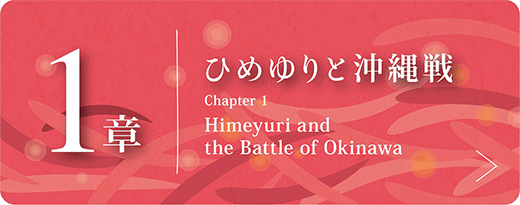戦後、アメリカの占領下にあった沖縄には、エンジニアなど技術職のアメリカ人が駐留していました。その中に、沖縄系ハワイ二世もいました。エンジニアとして米軍基地で働いていたハリー・儀間真一さんもそのひとりであり、読谷村にルーツを持っていました。戦後いち早く、ひめゆりの塔は建立されたものの、敷地を管理する環境は整えられていませんでした。放置されたままになっている塔に参拝している老婆の姿を見て、儀間さんは心を痛めました。1951年、儀間さんはひめゆり学徒隊の引率教師であった仲宗根政善先生(後の初代ひめゆり平和祈念資料館館長)を訪れ、「ひめゆりの塔を、今のまま放置してよろしいのでしょうか」と問いかけます。
ひめゆりの塔の現場を目の当たりにした儀間さんは、「戦争で亡くなったあの乙女たちをいつまでも丁重に弔ってあげるべきではないでしょうか。
ハワイには太平洋戦争で戦没した勇士たちを丁重に祭ってあるパンチボールがある。私ができることでしたら手伝わせてください」と仲宗根先生に申し入れました。

儀間さんは、友人・知人から寄付を募り、仲宗根先生に壕周辺の敷地約6,600平方メートルの購入資金を手渡しました。さらに敷地を塀で囲むことも提案し、費用を工面、仕事を終えた夜半、車のライトを頼りに、塀の設置にあたりました。ひめゆり同窓会は、儀間さんへ感謝の証に、敷地内に顕彰碑を建てました。儀間さんが設置した
After the end of the war, many American civilians worked in technical fields for the American occupational forces in Okinawa. Harry Shinichi Gima, a Hawaiʻi-born nisei with Okinawan roots in Yomitan Village, worked as an engineer on U.S. military bases.
Although the Himeyuri Cenotaph was built soon after the war, there had been no plan for its management.
Mr. Gima was saddened one day, when he witnessed an old woman praying at the neglected monument.
In 1951, Mr. Gima approached Himeyuri teacher, Seizen Nakasone (who would later become the first director of the Himeyuri Peace Museum). “Are we just going to leave the memorial in this state?” he asked, looking at the structure. “Shouldn’t we keep up this area forever as a place of mourning for all of those young girls who died in the war? In Hawaiʻi, we have Punchbowl (National Memorial Cemetery of the Pacific) and we honor those who fell in the Pacific War… Please, let me do whatever I can to help,” he said.
Mr. Gima set about soliciting donations from friends and acquaintances, and eventually raised enough money for professor Nakasone to purchase a 6,600 square meter area around the cave. He also provided the funds necessary to build a wall around the site, which he did, illuminating the construction area with his car’s headlights so he could labor into the night after work.
The Himeyuri Alumnae Association later built a memorial to Mr. Gima, in gratitude for his generosity. Mr. Gima’s wall remains to this day around the cenotaph.
儀間さんは、自身の行いを誇ることなく、仲宗根先生にも公にしないでほしいと頼んでいます。仲宗根先生は「私はその人柄に感激した。平凡でいて、実に非凡である。心の美しいゆかしい方で、心から尊敬された」と、儀間さんについて書き残しています。
2019年、ひめゆり平和研究所の調査チームは、儀間さんの親族にお会いする機会を得ました。
儀間さんとひめゆりの塔の関係について訪ねると、知らなかったという方がほとんどでした。彼がひめゆりの塔について多くを語らなかったことがわかりました。もともと無口なタイプだったともいいますが、無私の人だったのです。
儀間さんのイメージを尋ねると、とにかくメカニックが好きな方だったとのことです。エンジニアだったこともあり、車の改造やレースなどが趣味だったそうです。
ひめゆりの塔の敷地寄贈のエピソードからは伺えない、儀間さんの意外な一面を知ることができました。
He never boasted about what he did, and asked professor Nakasone not to mention it to the public. “His personality impressed me,” professor Nakasone said, “although humble, he was really an extraordinary man. An excellent, cheerful and respectable person with a good heart.” In 2019, a team from the Himeyuri Peace Museum’s Research Center had the opportunity to meet with Mr. Gima’s surviving relatives. When asked what they knew about his relationship with the Himeyuri Cenotaph, most had no idea. It turned out that he never talked much about it. He was remembered as a quiet and unselfish person. When asked what image stood out about Mr. Gima, his family said that, as an engineer, he loved all things mechanical. He enjoyed tinkering on cars and racing. The team was thus able to uncover another side of Mr. Gima that was never shown in the stories about his work on the Himeyuri Cenotaph.






